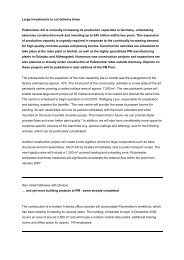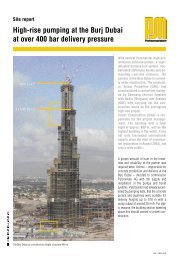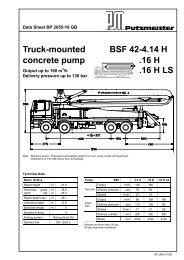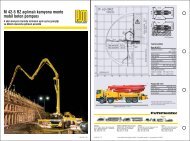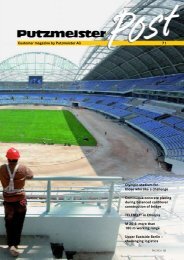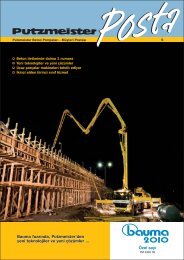2005 - Putzmeister
2005 - Putzmeister
2005 - Putzmeister
- No tags were found...
Create successful ePaper yourself
Turn your PDF publications into a flip-book with our unique Google optimized e-Paper software.
GermanyFlexible M 31 ”5-arms“ followthe pile drivers to the centimetreAfter starting up the first warehouse,ProLogis Germany, a logistics propertycompany, is currently having the secondphase of a 100,000 m 2 large logistics parkbuilt on the Genter Ufer close to theHamburg district of Finkenwerder.Due to the composition of the soil, thefoundations must be supported on concretepillars which are driven deep into thesubsoil by special pile drivers. As the maincontractor, DEPENBROCK GmbH & Co.KG (Bielefeld) has commissioned thecompany FRANKI GRUNDBAU GmbH& Co. KG (Seevetal) to drive the numerouspiles into the ground. Betonlift Hamburgwill fill the piles using truck-mountedconcrete pumps and highly flexibleplacing booms.When threading the 4 m long end hoses into thepile, the M 31-5 machine operator is supported by asite colleague, who then leaves the danger zoneduring concreting. The end hose is not connected tothe pile driver but remains loose.Whilst the foundations for the ProLogis 1warehouse (leased since autumn 2004) aresupported on a total of 2,500 piles, ”only“1,700 fully submerged piles (also as castin-situ concrete deep-driven piles orSimplex piles) are required for the Prologis2 base plate. The soil is not removed fromthe ground, using an auger, for example,when constructing the piles using thismethod Instead, huge pile drivers are usedto thrust deep into the supporting ground.To produce the piles, a driving pipe whichis sealed at the bottom with a base plate, isforced into the soil. To this end, projectmanager Holger Luttmann from FRANKIGRUNDBAU deploys up to four pile driverson the ProLogis construction site, with animpact power of up to 14 tons. As soon asthe positioning depth (13 – 18 m) for thepiles has been reached, a reinforcementcage is placed in the tube, filled with freshconcrete and then the steel tube is pulledupwards. The base plate remains in theground during this process. It now becomesthe foot of the concrete pile. After the concretehas set, the pillar head is exposed,shortened to the height required and a reinforcedhead foundation is produced inorder to carry the load generated by thefloor.Germany50 51Subsoil with no loadbearing capacitySubsoil with loadbearingcapacityLocating the pile.The pile is sealed with abase plate.Displacing the soilDriving the pile into thesoil using a head driverAn overview of the steps involved in producing a driven pileGWInserting the reinforcementcageThe piles’ loadbearing capacity can be veryaccurately measured and controlled via thenumber of impacts applied. If the subsoilcan carry the pillars – as it can in Hamburgport here – on sandy ground, loads of up to1,800 kN can be dispersed into the groundusing this pile construction method.Here, on the ProLogis construction site, the42 cm diameter piles are designed for loadsof up to 1,400 kN.The tubes inside the piles are concretedusing two BRF 31.16 H <strong>Putzmeister</strong> truckmountedconcrete pumps, which theBetonlift pumping service prefers for thisand other, similarly complicated concretingprojects (e.g.. for concreting tunnels andhalls). The five movable boom segmentsenable the pump operators to track the constantlychanging pile height, with the endhose radio remote control device. Thisaction requires a particularly high level ofconcentration from the concrete pumpoperating personnel. On the ProLogis constructionsite, the pile driver machine operatorsare now so pleased with the sensitiveboom guidance supplied by the Betonliftpump operators and their ”particularlysteady hands“ that they asked Betonliftexpressly if ”their“ operators could be usedto concrete the piles.Concreting the pileshaft and withdrawingthe pile. Thebase plate is thenlost.Capping the pile.Mounting the connectingreinforcement. Thepile is complete and,once it has cured, isready to support a load.Fig. FRANKI GRUNDBAUemployee assists the two machine operatorsin this task, by giving extremely precisedetails of the new location and in positioningthe support plates.The concrete used is a B25 type stillauthorised under an old standard, withgrading curve A-B and a cement ratio of320 kg/m 3 (CEM III/B), 80 kg/m 3 of aggregateand 0/16er grain. Due to the high levelof possible chemical aggression from theground and groundwater, the ProLogis constructionproject is classified as a B2 constructionsite, which is monitored externallyby construction experts. Before the pilesmade of cast in-situ concrete were driveninto the soil, FRANKI GRUNDBAU hadchecked the loadbearing capacity of thesand-based soil with some carefully preparedpressure samples.52120 piles concreted each day20 piles concreted from one location22PM 3652 GBFor the Pro Logis 2 construction project,four driving machines place the total of1,700 fully driven in piles in a 4 x 4 metresgrid – which is an average of 120 piecesper day. Wolfgang Steinert, constructionmanager for FRANKI GRUNDBAU: ”Thepile carries the loads through jacket frictionand tip pressure into the layers of soil.The concrete required to fill the piles isexpected to be approximately 0.15 m 3 permetre, corresponding to a quantity of about2 m 3 per pillar. Thanks to the large workingrange of the 31 metre booms, the truckmountedconcrete pumps can fill up to 20piles with concrete from one location. Onlythen is the pump moved. A third BetonliftProject manager Holger Luttmann and constructionmanager Wolfgang Steinert from FRANKI GRUNDBAU23PM 3652 GB



![Data sheet BSA 1005 D SV (TB 2206) [.pdf; 459.58 kb] - Putzmeister](https://img.yumpu.com/51174022/1/184x260/data-sheet-bsa-1005-d-sv-tb-2206-pdf-45958-kb-putzmeister.jpg?quality=85)
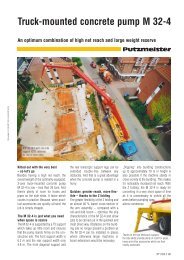
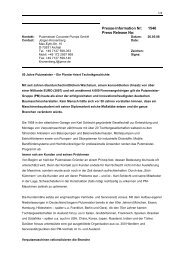
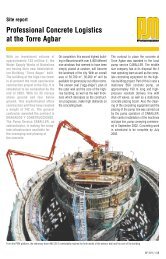
![Typenblatt CS 3095 [.pdf; 202.40 kb] - Putzmeister](https://img.yumpu.com/50530164/1/184x260/typenblatt-cs-3095-pdf-20240-kb-putzmeister.jpg?quality=85)
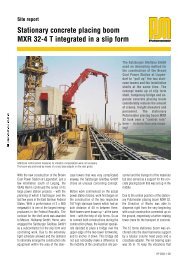
![M 47 Broşürü [.pdf; 527.92 kb] - Putzmeister](https://img.yumpu.com/49631771/1/190x141/m-47-brosuru-pdf-52792-kb-putzmeister.jpg?quality=85)
